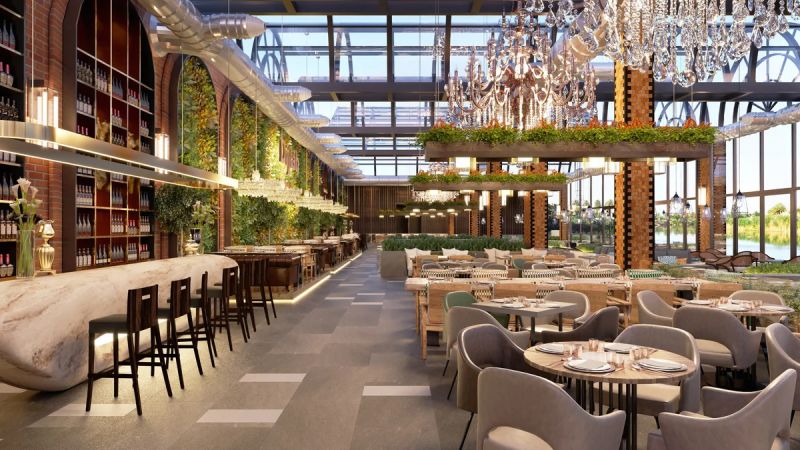In today’s dynamic culinary scene, dining out is about more than just food and service. Restaurants are increasingly focusing on improving every part of the eating experience, including the furniture that customers interact with. This evolution has given rise to the concept of smart seating, which combines technology, comfort, and utility to transform traditional restaurant furniture design.
Gone are the days when restaurant seating was only functional. Diners today expect more from their dining experiences, including comfort, ambiance, and even technological integration. Smart seating is at the forefront edge of restaurant furniture design, using innovative technologies to increase comfort and aesthetics while also streamlining operations and increasing customer satisfaction.
Restaurants are realizing that the correct furniture can significantly influence how customers view their whole dining experience. The tone is set by guests’ interactions with the venue as soon as they enter. Smart restaurant furniture and smart seating solutions, whether in the form of a snug booth with integrated charging stations or sleek, modular seating that adapts to group size, are reinventing the concept of dining ambiance.
Challenges in Traditional Restaurant Seating
Classic restaurant furniture, while frequently durable and dependable, presents various issues in the modern dining environment. Many institutions try to strike a balance between comfort, durability, and visual appeal. Fixed seating arrangements can limit flexibility, making it difficult to accommodate changing group numbers or modify layouts for special occasions. Maintenance of conventional furniture can also be expensive and time-consuming, with wear and tear frequently affecting the overall dining experience.
In contrast, smart seating technologies tackle these issues head-on. Restaurants can provide seating solutions that are not only long-lasting and aesthetically beautiful but also adaptable and simple to maintain, by utilizing technology such as IoT and sophisticated materials. The use of sustainable materials guarantees that modern seating meets environmental standards while maintaining quality and comfort.
Technological Innovations in Smart Seating
The inclusion of IoT has changed the way restaurants approach seating design. Consider seating that can change its settings based on individual preferences or ambient factors. Smart seating systems use biometric sensors to adjust comfort levels, guaranteeing that each diner has an optimal dining experience. AI systems forecast seating configurations, so saving space and increasing operational efficiency.
Also, modern materials and technologies, such as self-cleaning surfaces and antibacterial coatings, ensure that hygiene standards are satisfied while maintaining design aesthetics. Noise-canceling features and adaptable lighting help to create a comfortable dining environment, which improves the entire dining experience.
Benefits of Smart Seating for Restaurants
Smart seating provides numerous benefits to eateries and their customers. Customizable settings not only cater to individual preferences but also boost operational efficiency with automated maintenance warnings and energy-efficient solutions. Restaurants can boost table turnover rates by optimizing seating arrangements, resulting in greater income potential.
Similarly, creative seating designs help to improve brand recognition and client loyalty. Accessible elements ensure that all diners, regardless of ability, have a comfortable dining experience. Real-time feedback collection using smart seating analytics gives significant insights, enabling restaurants to constantly enhance their services and ambiance.
Future Trends in Smart Seating
Looking ahead, the future of smart seats holds even more intriguing developments. Augmented reality (AR) has the potential to transform interactive dining experiences, and adaptive seating designs are constantly evolving in response to customer feedback and preferences. Voice control and gesture recognition technologies are likely to become regular features, making interactions easier and more accessible.
Sustainability will remain a top priority, with eco-friendly materials and methods defining the next generation of seating options. 3D printing technologies may offer custom-designed seating that is perfectly suited to each restaurant’s distinct style and layout. Health monitoring technologies linked to seating might provide diners with real-time well-being tracking, boosting their overall experience.
Challenges and Considerations
While the benefits of smart seating are clear, adopting these technologies has its own set of obstacles. Initial investment expenses and ROI calculations must be carefully considered. Staff training is crucial for the effective use and maintenance of smart seating systems. Data privacy concerns about IoT-enabled devices must be addressed to protect client information and preferences.
Critical considerations include compatibility issues with current restaurant infrastructure, as well as regulatory compliance with safety and accessibility regulations. Managing technology obsolescence while guaranteeing smooth integration with other restaurant technologies necessitates meticulous planning and experience. Despite these limitations, smart seating has the revolutionary potential to improve the dining experience, making it a worthy investment for forward-thinking enterprises.
The Future of Smart Seating
In conclusion, smart seating solutions reflect a paradigm shift in restaurant furniture design, driven by technological innovation and a desire to improve the dining experience. As restaurants continue to embrace these developments, customers can expect dining experiences that are not just comfortable and visually appealing, but also adaptable and sensitive to their requirements.
The future contains endless possibilities for smart seating, ranging from individualized comfort solutions to interactive dining experiences powered by AR and AI. By tackling existing difficulties and embracing future trends, restaurants can position themselves as innovators, delighting consumers and assuring long-term growth in an increasingly competitive market. As technology advances, so will the dining experience, resulting in unforgettable moments for customers worldwide.
Stay in touch to get more updates & news on Mystories List!
